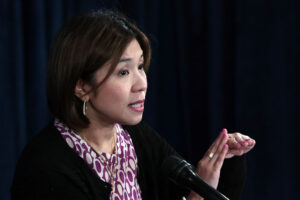BUDGET Secretary Amenah F. Pangandaman said on Monday that she sees no need to revise the government’s 6-8% gross domestic product (GDP) growth target this year.
Asked if she expects major revisions to the growth outlook this year, Ms. Pangandaman, who chairs the Development Budget Coordination Committee (DBCC), told reporters: “No, not yet.”
Ms. Pangandaman said the Philippines will not be significantly affected by US President Donald J. Trump’s tariffs, citing an earlier estimate of a 0.1% possible adverse impact on GDP in the next two years issued by the Department of Economy, Planning, and Development (DEPDev).
“I think, not based on the data that I saw from NEDA (DEPDev’s predecessor, the National Economic and Development Authority). But it’s just very rough data that they crunched. The impact is small. I think it’s less than 1%,” she said on the sidelines of a DBM event.
The DBCC meeting is provisionally scheduled for this month.
DEPDev Secretary Arsenio M. Balisacan has said that it may be unrealistic to expect to hit the upper end target amid global uncertainty over US tariff policy.
Philippine goods entering the US face a 17% tariff, the second lowest in the Association of Southeast Asian Nations (ASEAN) after Singapore was assigned a baseline rate of 10%.
However, the new tariffs have been suspended, except for those imposed on China, until July.
“All other things being equal, we expect the new policy to weigh negatively on net exports as a direct effect, and on consumption, employment, and the fiscal balance as second-round effects,” Ms. Pangandaman said in a separate e-mail to BusinessWorld.
Last year, the Philippines exported $12.14 billion worth of goods to the US.
“As an exporting country to the US, the additional tariffs may result in the lowering of prices of exported goods to make them more competitive when compared to other countries exporting the same,” she said.
Trade Secretary Ma. Cristina A. Roque has said that the tariffs are not a major worry as the Philippines has one of lowest rate compared to its regional peers.
Ms. Roque and Secretary Frederick D. Go, the Special Assistant to the President for Investment and Economic Affairs, will be in Washington between April 29 and May 2 for tariff talks with their US counterparts.
Ms. Pangandaman said she hopes the first quarter GDP will be “higher than what is expected” due to election campaign activities.
“But then, let’s be a little conservative because there are projects and programs that are withheld because of the for-later-release (FLR) funds and the election ban,” she said.
Mr. Balisacan and Finance Secretary Ralph G. Recto both expect the first quarter growth to hit 6%, which would exceed the revised 5.9% expansion in the first quarter of 2024.
The Philippine Statistics Authority (PSA) will release first-quarter GDP data on May 8.
Asked about recent developments on the 2026 budget preparations, she said: “We are looking for fiscal space.”
“There are a lot of programs and projects that our cabinet members want to pursue next year… And, of course, it’s the second half of the administration. So, we want more output from their departments,” she added.
Ms. Pangandaman said the Tier 1 proposals have been submitted.
“The Tier 1 ceiling of government agencies for FY 2026 amounted to P3,863.77 billion, which is higher by 14.3% or P483.41 billion when compared to Tier 1 ceilings for FY 2025,” she said.
Meanwhile, the Tier 2 proposal submissions are ongoing and may have exceeded last year’s P9 trillion.
The DBM is currently in the process of reviewing submissions of agency budget proposals for Tier 2 in time for the agency’s Executive Review Board Hearings in May.
In 2026, the overall National Expenditure Program will hit a record P6.793 trillion, up 7.38% from the budget bill signed in 2025. — Aubrey Rose A. Inosante

